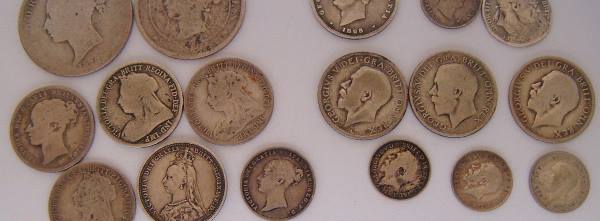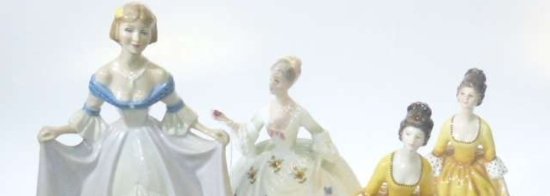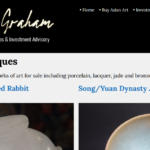It is thought by some that one of the worst fates for a spouse is to become a golfing widow or widower – but how much worse is it to be married to a collector of golfing memorabilia? After playing 36 holes on Sunday, chances are that the errant golfer will spend the afternoon gazing at his or her collection or disappearing into some charming book by one of the well-known golfing authors such as P G Wodehouse. True golf collectors will know, long before they learn the price of an article, whether they have to own it or not. Being able to afford it is another matter. Collecting has many similarities to the sport itself; and if you are afraid of becoming possessed, it may not be for you. It could become a very serious, time consuming and expensive hobby.
However, don’t immediately be put off by thoughts of the expense involved though, as there are still many objects that can be picked up relatively inexpensively. There are collectors of golf tees, cigarette cards, services, score cards and all sorts of ephemera, which doesn’t have to cost the earth, and you may well turn up something valuable in the course of your searches.
This is something of a double-edged sword. It is great news for any collector, but it is also when the trouble really starts, as from then on the hunger for rare and valuable items becomes ever stronger. To add to this unfortunate dilemma, is the fact that as your collection progresses, you will meet other collecting enthusiasts, and see their collections, and, most importantly, you will become more and more knowledgeable on the subject.
If after this warning you still want to start collecting, obtain one or two of the publications on golfing antiques and collectables and have a really good look through them as this will help you to pinpoint the items that appeal to you.
Most important to the historian are old books and artwork, without which we would know nothing of this royal and ancient game. Old golf books are, of course, an extremely popular field of collecting in themselves, and must also be considered as the one thing all aspiring collectors should arm themselves with. A wealth of information can be gleaned from them about the history of the game, the personalities, the courses and so on. They can help give your collection a theme or direction and the knowledge gained from them could save you a lot of money in ‘mistakes’.
There is no right or wrong place to buy. It is possible to have a good or bad buy at auction just as you can from a dealer, market or your best friend! If you do decide to approach the dealer, you may hear of one with a good reputation through personal recommendation. From your point of view, he must be someone you feel you can get on with and trust. If you have a lot of spare time, there are also the antique markets, car boot sales and so on. But a word of warning here; beware of fakes. Most bargains are not what they seem.
On one occasion at a market I found a lovely print of a golfing scene, rather dirty with broken glass and oak frame. I gladly paid 120.00 pounds for it, knowing that when cleaned it could fetch around 600 pounds – 800 pounds. Once at home I could hardly wait to get the print out of its frame away from the dirty stained glass – only to find that it was new and worth 5 pounds to 10 pounds at most! In contrast, one of my better buys was a table croquet set for 45 pounds, which instead of containing four croquet balls, was made up of two croquet and two golf balls. The golf balls turned out to be two beautiful hand-hammered Forgan Pattern Gutta Percha balls in mint condition and were worth around I,000 pounds each. From my point of view, a rather more memorable story than the first.
To look at the individual club makers, such as Hugh Philp and the McEwas, Parks and Forgans, is beyond the scope of this article, but there is much to be read about them in books on golf collecting, and greater investigation is a must for the keen collector.
Collecting putters can be a good way to start if you are interested in clubs. In this way it is possible to learn a great deal about the clubmakers, as most of them have made putters as well as other clubs. There are hundreds of different putters in all price ranges and one can spend years building up a respectable collection. It is possible to buy putters from a few pounds each up to thousands of pounds if you want something rare – say an item by a good maker, or one used by a famous player and with a history.
Having started with putters, unless you are extremely disciplined, you may suddenly find yourself diversifying and spending your hard-earned cash on ‘woods’ and ‘irons’, which unlike the numbered clubs of today, have delightful descriptive names like – ‘Driver’, ‘Brassie’, ‘Spoon’, ‘Driving Iron’, ‘Mid Iron’, ‘Rut Iron’, ‘Mashie’, and ‘Niblick’ to mention a few. In those days, a dedicated golfer wouldn’t describe a distance in yards, but would say, ‘It’s a drive and a mid iron’ or ‘a short spoon and a putt.’ Incidentally, some of the modern makers of golf clubs are now starting to bring back these original and attractive names.
The American club collectors seem to be more interested than their European counterparts in what one might call patent or pattern clubs, though I am not sure of the reason for this. Some of these clubs do seem to command very high prices. For instance, a good Giant Niblick can make up to 2000 pounds which seems rather a lot for a club that has been machine produced – and not in particularly small members, at that. The nicest patent club I was lucky enough to possess was a beautiful brass roller putter, made by Grays of Cambridge. This was an extremely rare piece, and in the 18 years I have been dealing in golfing memorabilia, I have only owned two and heard of one other.
In my opinion, the most attractive clubs are the long nosed clubs, dating from the eighteenth to the second half of the nineteenth century. These are real works of art, and were individually hand crafted by the makers. The member surviving to the present day is low, and their rarity, coupled with their beauty, has resulted in them being highly prized as collectors’ items.
Clubs from the 1870s and 1880s are a little more readily available, although these generally command high prices of around 700 pounds to 2000 pounds depending on the maker and condition. More commonly available are the slightly later transitional clubs from the 1880s onwards, and the scared head clubs with small heads. Even the fairly modern looking woods from the 1920s and early 1930s can be very attractive and are often picked up for between 20 pounds and 45 pounds.
The early steel shafted clubs do not as yet seem to be collected in any great number, but I am sure their time will come. Now would certainly appear to be a good opportunity to start a collection.
For obvious reasons, the most important item in a game of golf is the ball, and these are often the foundation for a collection. Once you begin to collect balls there seems to be no end to the obsession, as there are so many different types; the early wooden balls, featheries, gutta percha, smooth faced and patterned, and rubber core balls.
Probably the ball every collector would wish to own is the ‘feathery’ so called because it was made of a leather cover filled with a top hat full of boiled feathers. A feathery can cost anything from 1500 pounds to 15, 000 pounds, depending on condition and the maker’s name. Again, if you are in the market for one of these gems, beware of fakes.
All sorts of ceramic pieces with golfing themes were made from the 1890s to 1930s by major British, American and Continental factories. Makers such as Royal Doulton, Carlton, Clifton, Burslem, Gerz, Royal Bonn, Copeland, and the Foley China Company were responsible for some well-designed pieces, which can make a superb collection as well as a good display in a cabinet. It must be said that this may be appreciated more by non collecting members of the family, than a lot of clubs and golf tees.
Some interesting Royal Doulton Lambeth ware golfing ceramics were made in the early l900s. They depict golfers and caddies, with the figures in white relief on a tan background with blue or brown borders, and the pieces sometimes have a silver rim. These ceramics have turned out to be a very good investment for collectors as they are quite rare. Less rare, but still most attractive, are the golfing are the Royal Doulton Kingsware and Series Ware. The latter featured golfing figure by Charles Crombie, which were also illustrated in a comical book, the Rules of Golf, produced by Perrier in France in 1904.
There are, of course, many other golf related items that are highly collectable: figurines made in bronze, spelter or porcelain, silver novelty items including brooches, tee holders, pens, cigarette cases, vesta cases, books, artwork – the list is endless. The surprising thing is the diversity of golfing antiques and memorabilia reflecting the popularity of the sport through the ages.
Of course, one of the nicest things about golf collecting is the opportunities that arise to meet fellow collectors. As most golf collectors play golf; they tend to have a game whenever and wherever they meet. So it is possible to get to know some nice people, often whilst playing one of the country’s great golf courses.
In this respect golf collectors are really very lucky. After all, it would never really be possible for two humble tennis collectors to meet one spring morning at Wimbledon, exchange anecdotes over a cup of tea and play a leisurely game of tennis on Centre Court in the afternoon, or for that matter two horse racing collectors to have a race round Aintree, cricketing collectors to play at Lords, or football collectors to knock the ball around at Wembley. But nothing stops the golf collector from following in the footsteps of such masters as Tom Morris at St Andrews – and what’s more you could even do so with your hickories.
I will never forget an annual meeting of a lot of mad collectors at Musselburgh, all playing in old fashioned clothing and using hickory clubs, or the very memorable Centenary match at Aberdovey Golf Club where the ‘Ancients’ played the ‘Moderns’. Unfortunately the ‘Ancients’ lost, but no doubt there will be a replay in 100 years.




